‘Hush Up Sweet Charlotte’ even funnier and more campy than ‘Baby Jane’ parody
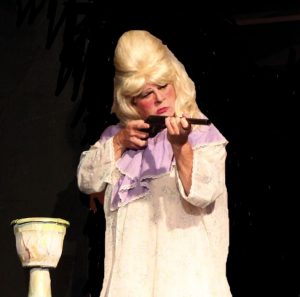 Last summer, Randall Kenneth Jones and Rob Green slayed Southwest Florida with over-the-top portrayals of the Hudson sisters in Lab Theater’s campy parody of the 1962 Bette Davis-Joan Crawford cult classic film Whatever Happened to Baby Jane. Jones has returned this summer to torment a new victim in Lab’s sequel, an even campier spoof of the sequel to Baby Jane, the 1964 Southern Gothic grand guigno, Hush Hush Sweet Charlotte.
Last summer, Randall Kenneth Jones and Rob Green slayed Southwest Florida with over-the-top portrayals of the Hudson sisters in Lab Theater’s campy parody of the 1962 Bette Davis-Joan Crawford cult classic film Whatever Happened to Baby Jane. Jones has returned this summer to torment a new victim in Lab’s sequel, an even campier spoof of the sequel to Baby Jane, the 1964 Southern Gothic grand guigno, Hush Hush Sweet Charlotte.
Both the play and Jones are better than last year – and that’s saying a lot!  The laughs are bigger, bolder and more protracted. They’re not just side-splitting. They’re of the fall-out-of-your-seat intensity and variety. But be careful if you have an aisle seat. That’s because in this production, a steady stream of actors make their way to the Hollis mansion’s front garden from the back of the Lab Theater house.
The laughs are bigger, bolder and more protracted. They’re not just side-splitting. They’re of the fall-out-of-your-seat intensity and variety. But be careful if you have an aisle seat. That’s because in this production, a steady stream of actors make their way to the Hollis mansion’s front garden from the back of the Lab Theater house.
Randall Kenneth Jones was magnificent last year as Jane Hudson. He’s even better as Cousin Miriam. As Baby Jane, Jones was deliciously cruel, villainous and reprehensible. But he was encumbered by the necessity of preserving Jane’s 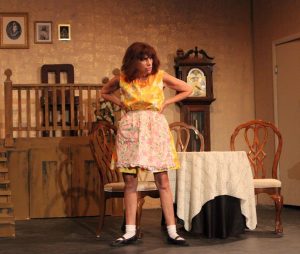 essential character as a tragic figure in the tradition of Sophocles’ Oedipus or Shakespeare’s Othello. As Cousin Miriam, he’s gloriously unrestrained. The bitch is diabolically manipulative. Ruthlessly Machiavellian. Blissfully amoral. There isn’t anything she won’t say or do to get what she wants – and what she wants isn’t fame, love or affection; it’s power, control and, above all, money.
essential character as a tragic figure in the tradition of Sophocles’ Oedipus or Shakespeare’s Othello. As Cousin Miriam, he’s gloriously unrestrained. The bitch is diabolically manipulative. Ruthlessly Machiavellian. Blissfully amoral. There isn’t anything she won’t say or do to get what she wants – and what she wants isn’t fame, love or affection; it’s power, control and, above all, money.
In the ’64 film, 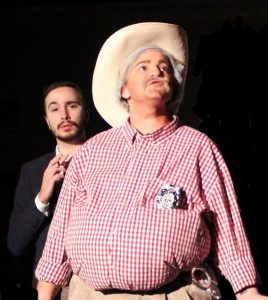 Olivia de Havilland elected to give Miriam a refined, reserved demeanor. Jones and Lab Artistic Director Annette Trossbach have gone in the other direction. Perhaps that’s in recognition that Hush Up Sweet Charlotte is, after all, a parody. Be that as it may, Miriam’s inner self warrants, nay mandates, a campier, more idiosyncratic and outlandish depiction of the character.
Olivia de Havilland elected to give Miriam a refined, reserved demeanor. Jones and Lab Artistic Director Annette Trossbach have gone in the other direction. Perhaps that’s in recognition that Hush Up Sweet Charlotte is, after all, a parody. Be that as it may, Miriam’s inner self warrants, nay mandates, a campier, more idiosyncratic and outlandish depiction of the character.
Miriam primps, poses and postures – not to impress anyone, but rather as a natural expression of her perceived self-importance. She masticates her lines with pronounced staccato – 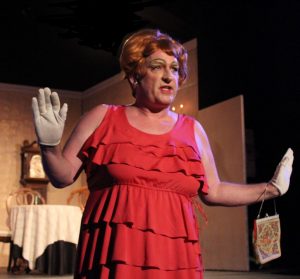 not merely for affect, but because Miriam devours words in the same way as people – with the rapacity of a gluttonous gourmet chef. Miriam aspires to a Nietzschean Will to Power – she is given to toxic self-expression unfettered by mores or social convention. She’s a classic study of people who victimize, bully and brutalize their way through life.
not merely for affect, but because Miriam devours words in the same way as people – with the rapacity of a gluttonous gourmet chef. Miriam aspires to a Nietzschean Will to Power – she is given to toxic self-expression unfettered by mores or social convention. She’s a classic study of people who victimize, bully and brutalize their way through life.
Already denoted by a versatile and illustrious career, Randall Kenneth Jones has never been better. 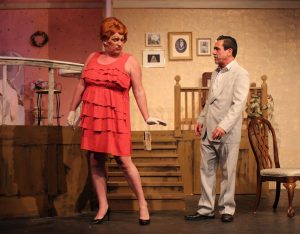 His portrayal of conniving Cousin Miriam ranks right up there with such cult classic performances as Tim Curry’s Frank N. Furter from The Rocky Horror Picture Show and Hugo Weaving’s Mitzi in The Adventures of Priscilla, Queen of the Desert.
His portrayal of conniving Cousin Miriam ranks right up there with such cult classic performances as Tim Curry’s Frank N. Furter from The Rocky Horror Picture Show and Hugo Weaving’s Mitzi in The Adventures of Priscilla, Queen of the Desert.
On the other end of the spectrum, Brian Linthicum’s beleaguered Charlotte Hollis is the perfect foil for her cousin’s machinations. 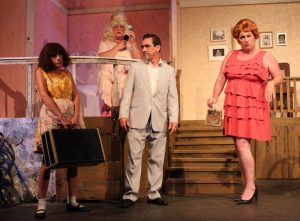 There are just some people who are professional victims. Sweet Charlotte is one of them.
There are just some people who are professional victims. Sweet Charlotte is one of them.
Charlotte had two great loves during her life. The first was her father, Big Sam Hollis. The other was her married lover, John Mayhew. The latter chooses the social event of the season, a glam party at the Hollis mansion, to end his affair with poor Charlotte. 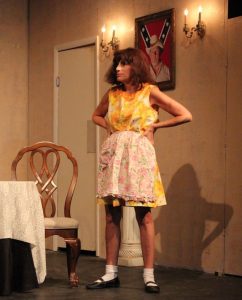 Little does Char know that her dad gave him little choice. Big Sam threw down on his philandering neighbor after learning of the tryst from Mayhew’s wife, Jewel. But then dear John lost a hand, his head and (obviously) his life. Her dress smeared in John’s blood, Char becomes the top suspect in the unsolved murder and is shunned by everyone in the small backwater Louisiana town. The problem is that Charlotte herself isn’t sure who did the deed. Was it her father, or did she kill old Johnny boy and then block the heinous crime from her fragile memory. (Chop Chop Sweet Charlotte, Chop chop ‘til he’s dead, Chop Chop Sweet Charlotte, Chop off his hand and his head.)
Little does Char know that her dad gave him little choice. Big Sam threw down on his philandering neighbor after learning of the tryst from Mayhew’s wife, Jewel. But then dear John lost a hand, his head and (obviously) his life. Her dress smeared in John’s blood, Char becomes the top suspect in the unsolved murder and is shunned by everyone in the small backwater Louisiana town. The problem is that Charlotte herself isn’t sure who did the deed. Was it her father, or did she kill old Johnny boy and then block the heinous crime from her fragile memory. (Chop Chop Sweet Charlotte, Chop chop ‘til he’s dead, Chop Chop Sweet Charlotte, Chop off his hand and his head.)
 But all that’s just so much backstory. We don’t meet the wizened and bedraggled Southern belle until some 37 years later. By then, Charlotte is barely clinging to her father’s mansion and the last shreds of sanity. After nearly four decades of isolation and self-imposed agoraphobia, she’s a mess in a dress. Linthicum captures Charlotte’s confliction (guilt over what she may have done and anger about what her sainted father may have done to her instead) and gnawing regret for the life she might have enjoyed but for John’s betrayal and ensuing death.
But all that’s just so much backstory. We don’t meet the wizened and bedraggled Southern belle until some 37 years later. By then, Charlotte is barely clinging to her father’s mansion and the last shreds of sanity. After nearly four decades of isolation and self-imposed agoraphobia, she’s a mess in a dress. Linthicum captures Charlotte’s confliction (guilt over what she may have done and anger about what her sainted father may have done to her instead) and gnawing regret for the life she might have enjoyed but for John’s betrayal and ensuing death.
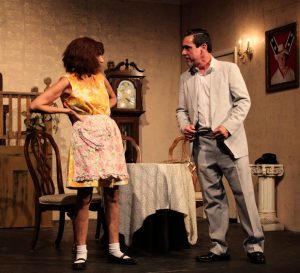 In the film, Bette Davis played the part with maniacal elan. Linthicum emulates her role model, but adds a number of his own touches to make the character come alive on stage. In particular, Linthicum realizes his character is a gritty survivor, if nothing else. But the problem is that she’s never encountered anyone as devious as her cousin or as duplicitous as Dr. Drew.
In the film, Bette Davis played the part with maniacal elan. Linthicum emulates her role model, but adds a number of his own touches to make the character come alive on stage. In particular, Linthicum realizes his character is a gritty survivor, if nothing else. But the problem is that she’s never encountered anyone as devious as her cousin or as duplicitous as Dr. Drew.
Over the course of rehearsal, Linthicum and Jones have developed a palpable on-stage chemistry. They play off each 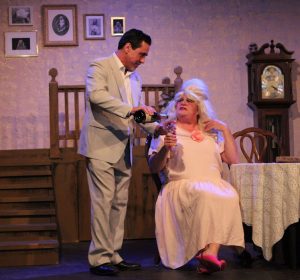 other and enhance one another’s performances. Nowhere is that more in evidence than a scene that comes late in the play when Miriam drags Charlotte along with her to dump a body into a gator-infested swamp down the road.
other and enhance one another’s performances. Nowhere is that more in evidence than a scene that comes late in the play when Miriam drags Charlotte along with her to dump a body into a gator-infested swamp down the road.
Without getting too far into the weeds, the scene takes place on an outcropping of stage that juts into the proscenium. From that proximity, the audience gets to watch as the crazy cousins drive over bumpy dirt roads to dump the body and 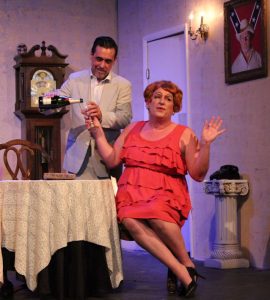 as Miriam tries to slap some sense into Charlotte at the end of their brief road trip. Miriam and Charlotte are definitely no Thelma and Louise. ‘Nuff said.
as Miriam tries to slap some sense into Charlotte at the end of their brief road trip. Miriam and Charlotte are definitely no Thelma and Louise. ‘Nuff said.
Sue Schaffel is equally mesmerizing. She sizzles in the role of Charlotte’s staunchly loyal maid. In the film, Agnes Morehead (Samantha’s mom in Bewitched) played this part so well that she garnered a Best Supporting Actress Academy Award nomination and a Golden Globe win. Schaffel’s Velna is a Southern-fried Ruth Buzzy. Her screechy bayou drawl adds to overall humorous tenor of the story. 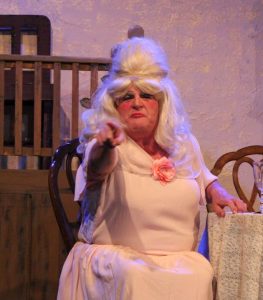 Her interactions with Miriam and the nefarious Dr. Drew are scene stealers, one and all. (But dear God, what would ever possess dear crusty Velna to turn her back on a bushwacker like Miriam?)
Her interactions with Miriam and the nefarious Dr. Drew are scene stealers, one and all. (But dear God, what would ever possess dear crusty Velna to turn her back on a bushwacker like Miriam?)
The rest of the cast turn in equally hilarious performances. Heather McLemore Shaw couldn’t be funnier as “spit-ding” Sheriff Luke Standish. Steven Coe channels previous roles in Play On!, Last Night of Ballyhoo and The Musical Comedy Murders of 1940 to put on the ritz as a snoopy British journalist eager to uncover the truth about John Mayhew’s murder all those years ago. Albert Gayoso excels as Dr. Drew Bayliss. Char Loomis, 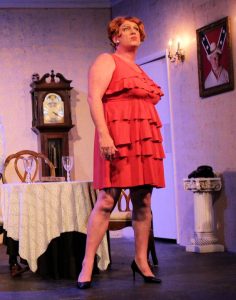 Kenneth Cosmo Ruisi and newcomer Danica Murray also contribute to the madness and mayhem that unfolds along the way.
Kenneth Cosmo Ruisi and newcomer Danica Murray also contribute to the madness and mayhem that unfolds along the way.
But don’t be lulled by the preceding into concluding that Hush Up Sweet Charlotte is little more than an aggregation of memorable characters, unapologetically over-exaggerated performances and uninterrupted laughs. At its core, Hush Up Sweet Charlotte is a cleverly-crafted murder mystery. The challenge of figuring out who actually killed that lyin,’ cheatin’ John Mayhew keeps the audience invested in the convoluted twists and turns unfolding on the stage on both an overt and subliminal way. Was  it actually Charlotte with the hatchet in the boat house? Or did Big Sam find out that his randy married neighbor was going to run away with his daughter after all? Or did Miriam do in Mayhew and let her rich bitch cousin take the fall? The nagging who-dunnit question is insidious. It tugs at the back of the mind even in the midst of outrageously
it actually Charlotte with the hatchet in the boat house? Or did Big Sam find out that his randy married neighbor was going to run away with his daughter after all? Or did Miriam do in Mayhew and let her rich bitch cousin take the fall? The nagging who-dunnit question is insidious. It tugs at the back of the mind even in the midst of outrageously 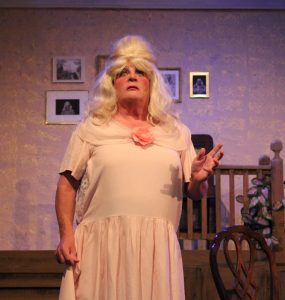 funny sequences. It unifies, lends cohesion to the plot and provides impetus to the characters’ thoughts and motives.
funny sequences. It unifies, lends cohesion to the plot and provides impetus to the characters’ thoughts and motives.
Last year, a host of current and prospective Lab patrons experienced their own regret over having missed Whatever Happened to Baby Jane – a Parody of the Horror. Admittedly, there exist lots of reasons to miss any stage production. A plethora of other events and happenings compete for your scarce reserves of time, attention and discretionary dollars. Don’t be diverted! This is a show Southwest Florida will be talking 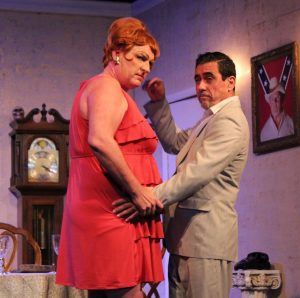 about for years, and you really don’t want to be caught on the outside looking in. Or stated a little differently, this is one occasion in which Coca Cola beats Pepsi, if you catch my drift.
about for years, and you really don’t want to be caught on the outside looking in. Or stated a little differently, this is one occasion in which Coca Cola beats Pepsi, if you catch my drift.
May 31, 2018.
- RELATED POSTS.
Lab’s ‘Hush Up Sweet Charlotte’ drag-tastic parody of Bette Davis-Olivia de Havilland film
Brian Linthicum plays Charlotte Hollis in Lab’s ‘Hush Up Sweet Charlotte’ parody
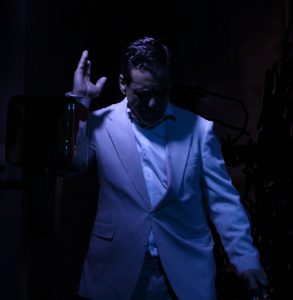 Randall Kenneth Jones plays conniving cousin Miriam in Lab’s ‘Hush Up Sweet Charlotte’
Randall Kenneth Jones plays conniving cousin Miriam in Lab’s ‘Hush Up Sweet Charlotte’
Meet ‘Hush Up Sweet Charlotte’ actor Sue Schaffel
Heather Shaw is new sheriff in town for Lab’s ‘Hush Up Sweet Charlotte’
Steven Coe part of the cast of ‘Hush Up Sweet Charlotte’
Char Loomis in cast of Lab’s ‘Hush Up Sweet Charlotte’
Meet ‘Hush Up Sweet Charlotte’ actor Albert Gayoso
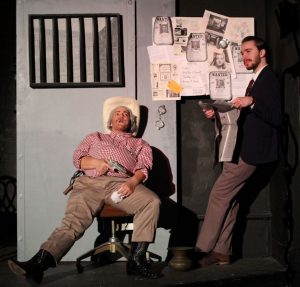 Meet ‘Hush Up Sweet Charlotte’ actor Danica Murray
Meet ‘Hush Up Sweet Charlotte’ actor Danica Murray
Meet ‘Hush Up Sweet Charlotte’ actor Kenneth Cosmo Ruisi
‘Hush Up Sweet Charlotte’ play dates, times and ticket info














 Tom Hall is both an amateur artist and aspiring novelist who writes art quest thrillers. He is in the final stages of completing his debut novel titled "Art Detective," a story that fictionalizes the discovery of the fabled billion-dollar Impressionist collection of Parisian art dealer Josse Bernheim-Jeune, thought by many to have perished during World War II when the collection's hiding place, Castle de Rastignac in southern France, was destroyed by the Wehrmacht in reprisal for attacks made by members of the Resistance operating in the area. A former tax attorney, Tom holds a bachelor's degree as well as both a juris doctorate and masters of laws in taxation from the University of Florida. Tom lives in Estero, Florida with his fiancee, Connie, and their four cats.
Tom Hall is both an amateur artist and aspiring novelist who writes art quest thrillers. He is in the final stages of completing his debut novel titled "Art Detective," a story that fictionalizes the discovery of the fabled billion-dollar Impressionist collection of Parisian art dealer Josse Bernheim-Jeune, thought by many to have perished during World War II when the collection's hiding place, Castle de Rastignac in southern France, was destroyed by the Wehrmacht in reprisal for attacks made by members of the Resistance operating in the area. A former tax attorney, Tom holds a bachelor's degree as well as both a juris doctorate and masters of laws in taxation from the University of Florida. Tom lives in Estero, Florida with his fiancee, Connie, and their four cats.